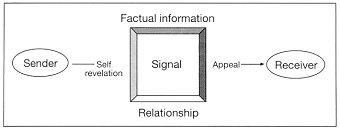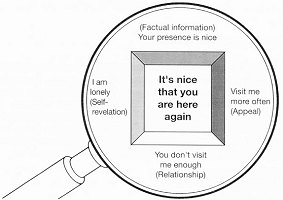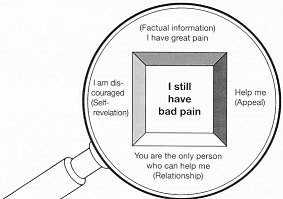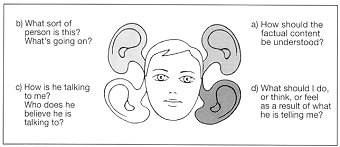Discussion techniques
- General principles
| One can't not communicate. |
| Watzlawick |
| 1. |
Factual
content (information) |
| 2. |
Self-revelation |
| 3. |
Relationship
(contact) |
| 4. |
Appeal |
A simple example from daily
life can be used to explain this. The mother greets her son, who does not
often visit her, with the words: "It's nice that you're here again!"
Breaking down the signal
soon shows that there is really more than one message hidden in the sentence.
The first message explains
the facts. The fact that you are here is good. We immediately sense
however that this sentence contains more than a simple statement.

The 4 messages of a signal
(modif. from Schulz von Thun)

The 4 messages of the
signal: "It's nice that you 're here again" under the magnifying glass
of the communication psychologist (modif. from Schulz von Thun)
For example, it says something
about the mother who is sending the signal. The mother is speaking from
the heart about her feelings with the sentence: "It's nice that you're
here again." She is letting it be known that she has missed her son, that
she wanted to see him, and that she is pleased to see him again now. She
is letting it be known how she feels. This self-revelation is the
second
message in the signal.
The third message
says something about the relationship of the son to the mother.
This message usually contains two different messages: the first expresses
what the sender expects from the receiver, and the second, what the relationship
(contact) is between the sender and receiver. The example "It's nice that
you're here again" has an unmistakably critical undertone. The mother also
wants to say: "You don't take enough care of me". By doing this, she says
something about the son, as receiver of the report. At the same time, however,
this sentence also implies something about the closeness and the trust
of the relationship between herself and her son.
The fourth message hidden
in this sentence contains a clear appeal: the mother would like
to use the sentence to express the wish: "You should visit me more often!"
Whenever we speak with one
another, we must be aware that the signals that we give to one another
contain several concurrent messages, which can be of very different weight.
Also the message which appears to be the most important (usually the information)
may not be the most important at all.
This gets even more complicated
by the fact that sender and receiver believe different messages of the
signal report to be the most important for them. It can for example happen
that the receiver believes that the factual information is the most decisive,
but the sender is much more interested in the appeal or the relationship.
It is clear that extensive misunderstandings can develop between
the two, even though the signal which has been sent seems completely clear
and unmistakable.
It may be that the son in
the example given above cheerfully accepts that his mother is pleased to
see him, but no more than that, and therefore doesn't bother to visit her
more often in the future. This signal would then have been unsatisfactory
for the mother, because her son had not "understood" the three messages
which were of more importance to her (her feeling of loneliness, her mild
criticism of his behaviour and her appeal that he should visit her more
often).
A basic fact of communications
can be deduced from this: there are usually 4 things that happen when speaking:
| 1. |
When
I speak, I share a fact —> information. |
| 2. |
When I speak,
I also say something about myself —> self-revelation. |
| 3. |
When I speak,
I tell the other person what I think of him and how we relate to one another
—> relationship. |
| 4. |
When I speak, I seek to
have an influence on the other —> appeal. |
Another example from daily
practice can be used to clearly demonstrate the various messages. During
the morning ward round, the patient says to the doctor: "I still have bad
pain."

Breakdown of the signal:
"I still have bad pain" under the magnifying glass of the communication
psychologist (modif. from Schulz von Thun)
It is not obvious that this
apparently simple statement contains several messages: Everybody understands
the message "I have bad pain" (factual content or information). The second
message is one about the speaker herself (self-revelation). We could presume
that the patient would like to express that she is disappointed about the
experience she has had so far with her treatment, perhaps also losing courage
or feeling confused. The fact that she is approaching the doctor says something
about her relationship with the doctor who is treating her. This is something
like: "I am telling you that I have bad pain, because you are the only
one who can do something about it." However in this message is also something
about her attitude to the doctor: "I am approaching you, because I trust
you." The relationship message therefore not only contains a statement
about what she thinks of him, but also how she relates to him. One cannot
miss the 4th message, the appeal: "You should help me!"
This means that when somebody
speaks to me and I would like to grasp all of the messages of this
statement, it works best if I answer the following 4 questions:
| 1. |
What
is the factual content of the report? |
| 2. |
What is this
telling me about the other person? |
| 3. |
What does the
other person want me to know about myself and about our relationship? |
| 4. |
What does he want to achieve? |
| top |
 |
|
Anatomy of the signal
The signal in interpersonal
communication is the sum of the messages, which the sender sends across
to the receiver. It is a "complete many-faceted packet, including both
verbal and nonverbal components" (F. Schulz von Thun).
The extent of this
signal can vary considerably, and there does not have to be a form correlation
between the extent and the amount of information it contains. For example
the information contained in the one word: "Help!" shouted by a drowning
man is far greater than that in a page of a circular letter covered with
words from a German electricity company, announcing in effect, that there
will be a small increase in the price of electricity in the following year.
Even silence (as a
particular sort of not speaking) is a form of communication. Silence is
not just "not speaking", but can involve consciously refraining from to
speaking, even though I should speak or somebody is expecting it from me.
This is the extreme of the basic principle of Watzlawick (1969) summed
up as: "One can't not communicate".
The message given by silence
is inevitably very difficult for the receiver to interpret as it can mean
so many things. How should one interpret the patient who, when asked how
he is, turns towards the wall and does not reply. Perhaps the self-revelation
part of the message is: "I feel so sick that I can't even say it". The
relationship part of the message is perhaps: "You are not the person that
I want to talk to about it", or "I don't trust you", or "I am so disappointed
with results of treatment so far, that I don't want to tell you how I feel".
The appeal is probably: "Leave me alone!". "Don't talk to me!".
In order to understand the
message, it is important to determine whether it contains an implicit
message as well as the explicit one. Something is expressed directly
with the explicit message, whereas the implicit message expresses
it indirectly. In addition, this is made more complicated by the fact that
there are explicit messages which may be actual or apparent.
For example, the explicit
message: "I'm going to bed now" cannot be misunderstood. The signal: "It's
nearly midnight" probably contains the same message, namely "I would like
to go to bed". Perhaps the receiver took this at face value, whereas the
sender possibly would like to express something completely different i.
e. "It's is nearly midnight, but I am working so well that I want to carry
on".
All messages in a
report can be explicit or implicit, which means that there is a great danger
of misunderstandings in the field of implicit messages. It can be very
instructive to examine any everyday conversation for the implicit and explicit
messages that it contains. Usually it will be found that the proportion
of implicit messages is much higher than one would expect.
One of the basic abilities
in successful communication is to determine which is the true major
message of a signal. Is it factual information which has been expressed
or described, or is the real request hidden in the implicit message?
Not recognizing implicit
messages in discussions between doctors and patients can lead to profound
disorders of communication. The patient who says: "I get such a bitter
taste in the mouth from the red pills" could be taken as a purely explicit
message with a clear factual content (subjective drug intolerance). The
implicit messages, which this report (probably) contains as well or even
first and foremost are more difficult to identify. Perhaps the patient
was trying to say: "I think medicines are poisonous", or "I don't want
to take these tablets any more, as they don't suit me". "I doubt if these
are the right tablets for me", "Perhaps these tablets taste so bad because
the diagnosis is not correct", "I don't really believe that your treatment
will work", "I don't want you to treat me" or "Nothing can help me now!".
What possibilities are there
to determine whether a signal contains implicit messages?
One of the basic prerequisites
is active listening (see Chapter on this subject  ).
A further way is that of systematically listening out for implicit messages:
this means putting out a "second internal antenna" to pick up the implicit
messages of the signal. In other words, it is a matter of consciously remembering
that a high proportion of signals contain implicit messages along with
the explicit message. The third method is a very careful observation of
non-verbal parts of the signal, which involves the analysis of movements,
gesticulations and phonetics. ).
A further way is that of systematically listening out for implicit messages:
this means putting out a "second internal antenna" to pick up the implicit
messages of the signal. In other words, it is a matter of consciously remembering
that a high proportion of signals contain implicit messages along with
the explicit message. The third method is a very careful observation of
non-verbal parts of the signal, which involves the analysis of movements,
gesticulations and phonetics.
It is the non-verbal components
of the signal which "qualify" the messages. If there is congruence
between them and they both point in the same direction, the report is "true".
There are contradictions between verbal and non-verbal messages in an incongruous
report.
For example: the young girl
who turns her cheek away from her lover's kiss with the words: "No, because
I don't love you" is sending a congruous signal. However an incongruous
signal is sent by a cyclist after a fall from his bike, who when asked
if he is alright replies: "Life is wonderful" with pain written all over
his face.
Unfortunately it is not always
as easy to spot congruence and (what is far more important) incongruent
as in these examples. The contradiction between verbal and non-verbal parts
of a signal can be relatively small and may not reveal the full extent
of the incongruence.
| top |
 |
|
Metacommunication
It is inevitable that communication
always runs on two levels: that of the actual communication and on the
level of metacommunication. The phenomenon of metacommunication
again clearly shows just how complicated the course of sending information
between people has become.
Metacommunication means communication
about communication, or "to unravel the way in which we deal with each
other and about the way in which the report we sent is meant, as well as
sorting out the signal we receive, and how we react." (F. Schulz von Thun).
Metacommunication can also
run explicitly or implicitly. In the true sense of the word, metacommunication
is explicit communication. I. Langer used a picture to try to make the
concept of metacommunication easier to understand. The discussion partners
agree to move to a hillock to get away from the hustle in which they were
tangled up. At this vantage point, sender and receiver make the manner
in which they are dealing with each other the subject of their discussion.
Explicit metacommunication which is used economically can be an excellent
method of re-establishing mutual understanding by consciously analyzing
and talking about the factors which are disturbing conversation. Parallel
to the communication on the level of a signal, there is always communication
on the meta-level in the sense of implicit metacommunication. This is the
"this is meant" part of every signal. Thus the messages at both levels
"qualify" each other. J. Haley (1978) differentiated 4 possibilities by
which the signal could be qualified in either a congruent or incongruent
way: qualification by context, the way of formulation, by movements and
gesticulation as well as the tone of voice.
When the Countess in Tolstoi's
"Anna Karenina" dismisses the young Ljewin in a cool and dry tone to the
words: "We shall be pleased to see you", then such parting is experienced
by the one leaving as a classical example of implicit metacommunication.
He was aware that the factual content of the signal ("We shall be pleased
...") was a polite but empty phrase, as the true message was expressed
by the tone of voice. The correct decoding of a signal is also bound up
with the ability to recognize the metacommunicative content. The nature
of implicit metacommunication can be summed up briefly as: "When I send
a signal, I also send (whether I want to or not) a message about how this
signal is meant to be received" (F. Schulz von Thun).
| top |
 |
|
Hearing the signal
It is almost a coincidence if
the sender correctly codes the signal to say what he would like to say
and if the receiver in turn decodes it as the sender meant it, even though
it is presumed to happen all the time in the course of communication between
people.
The mere recognition that
each signal contains 4 messages, which can be in turn either congruent
or incongruent, explicit or implicit, and that there is metacommunication
in addition, raises reasonable doubt whether talking to one another and
understanding one another is as simple as it is made out to be.
The complexity of this procedure
becomes even more obvious when we realize that the correct decoding of
the signal by the receiver means that he has to have a particular ear for
each of the messages of a signal; in other words, he has to have "four
ears". He needs a factual ear, a relationship ear, a self-revelation ear
and finally an appeal ear (see figure).

Correct understanding
requires the receiver to have "4 ears" a) Factual ear b) self-revelation
ear c) relationship ear d) appeal ear (mod. from F. Schulz von Thun)
The factual ear checks
the signal with the question: "How is the factual information to be understood?".
The self-revelation ear would like to hear something about the person
opposite: "What sort of person is this?" The relationship ear (which
is often very sensitive) is used by the receiver to ask himself: "What
relationship does he think he has with me? What does he think of me?" And
with the appeal ear, he poses the question: "What does the sender
want to achieve?"
The completely different
ways in which the signal can be "taken" are shown in the following simple
question, asked by a husband during breakfast: "Where did you buy this
bacon?"
If the wife receives this
signal with the factual ear, she will reply: "In the supermarket". If she
hears it with the excessively sensitive relationship ear, she will take
the question as a criticism of her housekeeping, and reply: "You can eat
breakfast in the canteen at work if you like". However if she picks it
up with self-revelation ear, then this might be one more confirmation of
her husband's nosiness, and release the reaction: "Do you have to know
everything?". If the wife understands this as an appeal, she would reply:
"I can buy it from the butcher instead of the supermarket next time".
Obviously the receiver receives
all 4 messages of the signal at the same moment, filters them to a greater
or lesser extent, and hears with more than one ear. One of the fundamental
problems of communication is that the reaction of the receiver
to the signal depends on whether he is aware or unaware that he is more
likely to hear with one ear.
The trained receiver must
have the ability to receive the signal that the sender is transmitting
with all 4 ears. Major disorders of communication can arise if he only
hears with one "ear" (for example, with the factual ear or the relationship
ear, because he has consciously or unconsciously closed the other ears).
For example, men who tend
to take up technical or academic careers choose to hear with the factual
ear, and receive no other message apart from the factual content. On the
other hand, marriage partners, particularly when they are under stress,
only receive in the relationship ear, and are unable to pick up a factual
statement. They are "lying in wait for one another".
A well-trained self-revelation
ear is very important for the doctor, as this is his diagnostic
ear. He uses this to sift out whatever can lead him to understand his
patient. Even when the patient has an emotional outburst, his self-revelation
ear allows him to have a better attitude to the patient than if he were
using only his relationship ear.
Of course this does not mean
that the doctor should "switch off" the relationship ear completely, and
listen only with the self-revelation ear and the factual ear, as this would
result in the patient being observed as a diagnostic object, and rob the
doctor of the ability to be affected or involved.
Schulz von Thun has pointed
out the additional danger of "psychologization", which results if
the self-revelation ear alone is used (or rather misused). The factual
content of a signal is ignored, and the signal only examined under the
aspect of what kind of person is hidden behind this signal. The receiver
judges all of the statements of the other under the motto: "He only says
that because he is made up in that way."
A well-trained self-revelation
ear is vital for active listening. It allows us the possibility
of sensing the thought and affective world of the other, and not to regard
him as just an object, or to continue to judge him from a human point of
view.
The appeal ear also
plays an important role in discussions between doctors and patients. If
the appeal ear is not tuned in, many requests, desires, hopes and expectations
of our patients would be ignored, as analysis of the factual content of
their signals would leave them unheard.
A particularly ominous example
is that of "overhearing" (in the sense of "overlooking") the intent to
commit suicide. This may be considered to be the final appeal to those
around, and can probably only be picked up with a very finely-tuned appeal
ear, which warns us about cries for help made with faintly-transmitted
signals during the course of discussion.
The appeal ear can also be
used diagnostically when we need to review, and ask about the objective
of a statement or way of behaving. It was Alfred Adler who employed the
method of the "what purpose does it serve" question, such as for example:
"What advantage do you derive from your migraine?"
If a problem in communication
has arisen, the receiver should go through the following check-list:
1. What are the messages
in the signal?
2. Which was the main
message?
3. Does the signal also
contain implicit messages?
4. Was the signal congruent
or incongruent?
5. What was expressed on
the level of metacommunication? (the "that-is-what-is-meant" part
of the signal)
6. Have I picked up the
signal with 4 ears or with only one? |
|
The content of the signal which
is transmitted by the sender, is not (as in a postal package) identical
to the content which "gets to" the receiver.
What somebody says is simply
not identical to that which the other hears. We call it misunderstanding,
and tend to look for blame instead of for the cause. Understanding, as
well as misunderstanding, are part of the nature of every communication.
| The knowledge that each
signal contains various messages, as well as the ability to receive signals
with 4 ears, are the best guarantee that misunderstandings can be minimized
in communication between people. |
|
| top |
 |
| previous page |
 |
| next page |
 |
|
|
Linus
Geisler: Doctor and patient - a partnership through dialogue
|
|
©
Pharma Verlag Frankfurt/Germany, 1991
|
|
URL
of this page: http://www.linus-geisler.de/dp/dp06_speech.html
|
|